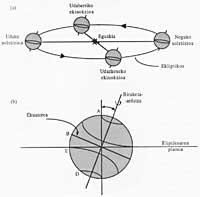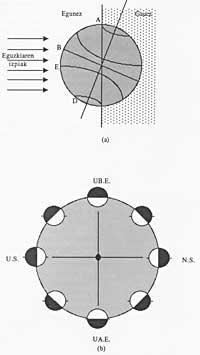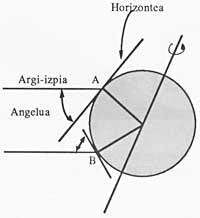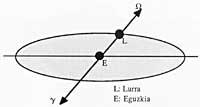Seasonal incidences
1986/06/01 Arregi Bengoa, Jesus Iturria: Elhuyar aldizkaria
In June we have the night of San Juan a very special night. It is usually considered the shortest of the year and are special celebrations that night. These things and, in short, postseasonal follow-up are a well-known phenomenon, but what is the reason behind this follow-up?. As we will see below, this phenomenon so important for our life is due to a detail that appears in the axis of rotation of the Earth: angle of 23°26'21" with the plane of the earth orbit, that is, with the plane of the ecliptic. See figure 1(b).
If the Earth's turning axis were perpendicular to the ecliptic plane, the day (considered as clear hours) and the night would be equal throughout the year. In addition, each specific point on Earth would receive the rays of the Sun in the same conditions throughout the year. Consequently, the temperature would always be very homogeneous. Specifically, points of equal latitude would receive the rays of the Sun with the same inclinations. The closer the rays are, the greater the amount of heat they would receive per unit of surface and time (see figure 2). Therefore, the highest temperatures would have in the equator and as we approach the poles would fall symmetrically, being minimal at both ends.
Figure 1(a) shows the relative positions of the Earth with respect to the Sun, taking into account the inclination of the axis. Figure 3 will help us to understand what happens in these different positions. In figure 3(a) we have taken the Earth at the time the winter solstice occurs in the northern hemisphere (Henceforth, although it is not mentioned, when we speak of a solstice or equinox, it will always be corresponding to the northern hemisphere). If in this situation we take point A of the image, it is evident that from it the Sun is not seen 24 hours a day.
The Sun has remained just below the horizon. When the Earth is at a later point following its orbit, the Sun begins to appear above the horizon of point A, remaining longer each day. Points A and all other parallels are those that define the Arctic polar circle and their latitude is 66°33'39". The higher the latitude A, the longer the night will be, with six months in the north pole (time between equinoxes).
This last detail can be seen better in figure 3(b). In it we have seen above the orbit of the Earth and have covered the night part of the Earth in dark. As we said, the North Pole is dark from the day of the equinoculation of autumn, in which the Sun is hidden below the horizon, until the spring equinox arrives, when the Sun rises above the horizon.
On the other hand, if in figure 3(a) we take a point B, you can check that it has 12 clear hours a day, as it will happen throughout the year. From point B the night lasts more than 12 hours and in each parallel spend the longest night of the year. For minors of point B the night is shorter the closer to the pole. At point D the Sun is not hidden throughout the day and this point defines the polar antarctic circle. As we go towards the South Pole, the time that the Sun does not hide is greater and in the South Pole we have a day of six months.
The height that takes the Sun (and in general any star) in the sky, measures the angle that forms the observer and the line that forms the Sun with the horizon, as we have done in figure 4 with two points of the two hemispheres. Taking into account this, to finish the study of the winter solstice we refer to point E. In it, this day, the Sun is located at the zenith, on the vertical, that is, at an angle of 90º. This point defines the tropic of capricorn and those of more negative latitude never see the Sun in the zenith, but by another smaller angle, with the consequences that it entails for the use of heat.
After the fourth of the year, the Earth will be at the spring equinox. Then the Sun is at the zenith of the points of the equator and in all the points of the Earth, except at the poles, the night and the day are equal. From this point, in the north the duration of the nights is still shortening being minimal in the summer solstice. Here they can be repeated, changing the hemispheres, all we have said about the winter solstice. The northern tropics are called Cancer.
After the summer solstice, the trends change and the night begins to stretch in the north and in the south, of course. In the equinox of autumn the night and the day return to equal. Finally, with another quarter back the cycle closes and we return to the winter solstice.
The climatic or meteorological changes associated with the seasons of the year depend on the duration of the night of each region and the inclination to which the rays of the sun arrive. Therefore, in the tropical regions the changes are small because throughout the year the duration of the night and the inclination of the rays varies little.
It should be noted, on the other hand, that the time changes that the seasons of the year imply are delayed with respect to them. Thus, for example, the biggest calors of the summer do not occur around the day of San Juan, but at the end of July and early August. The causes of this phenomenon are found in the distribution of sea water temperatures. The seas store the heat much more easily than the earth and hence the ability to limit time. However, the waters do not reach their highest temperature at the end of June, but later. This inertia effect causes a delay.
There is still another effect that affects the duration of seasons and climatology. As can be seen in figure 5, the apex of the Earth's orbit is around the summer solstice. This indicates that summer is the longest season and the shortest winter (remember that we always talk about the northern hemisphere). In addition, the northern summer is not as warm as the southern summer, because it is farther away from the Sun. On the contrary, in the north winter is somewhat more temperate, as it occurs when the Earth is closer to the Sun.
So this year we will end the summer saying it starts at 18 hours and 30 minutes (official time) on June 21.

Gai honi buruzko eduki gehiago
Elhuyarrek garatutako teknologia










